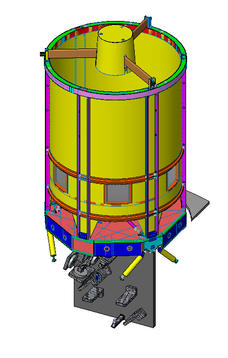It may be updated in the future, but it is not currently being maintained.
Optical/IR Telescope
 The integrated optical/IR telescope (IRT) system will carry out immediate follow up over the 0.3 to 2.2 um spectral range, allowing the detection and detailed study of afterglows from bursts over the redshift range from near 0 to 20. These observations will allow us to localize the burst, follow the light curve of the event as it fades, and through the study of intergalactic absorption, determine the composition and ionization structure of much of the universe. The same system is ideally suited for measuring redshifts and spectra of the large AGN sample discovered with the HET on EXIST.
The integrated optical/IR telescope (IRT) system will carry out immediate follow up over the 0.3 to 2.2 um spectral range, allowing the detection and detailed study of afterglows from bursts over the redshift range from near 0 to 20. These observations will allow us to localize the burst, follow the light curve of the event as it fades, and through the study of intergalactic absorption, determine the composition and ionization structure of much of the universe. The same system is ideally suited for measuring redshifts and spectra of the large AGN sample discovered with the HET on EXIST.
The IRT consists of a 1.1 m telescope combined with an Optical/Infrared Spectrometer (OIS). The IRT Optical Telescope Assembly (OTA) is based on the NextView Commercial Remote Sensing (CRS) optical payload recently developed by the ITT Corporation Space Systems Division (SSD) and launched in 2008.
The light entering the intrument will be divided into 4 bands (0.3-0.6, 0.6-0.9, 0.9-1.6, 1.6-2.2 um) through double-stage dichroic beam splitters. Two HiViSi CCDs will collect the lights in the visible band and two HAWAII 2RG HgCdTe detectors (JWST NIRACAM) cover the IR band. In each band, a half of the detector is used as a 2.5' x 5' diffraction-limited imager to provide the highest sensitivity for the detection of faint bursts, and for following bursts as they fade. The other half is used a slitless prism-based spectrometer, providing spectral resolving power of 10 over a 2.5' x 5' field of view. The imaging section is also used to provide feedback for fine guiding using a tip-tilt mirror in the instrument. This design allows the spectrometer to be immediately pointed at the location of the GRB, and a spectrum immediately obtained, allowing redshift determination and position location. In addition, an edge of the detector is devoted to an R~1500 single slit spectrometer. After the burst position is localized, it can be moved to the slit of this system, and a higher resolution spectrum obtained, which provides information on the ionization structure and chemical composition of the universe over the z ~0-20 range.
- OTA
- FPA: HiViSi (Visible) and HAWAII2G HgCdTe (IR)

